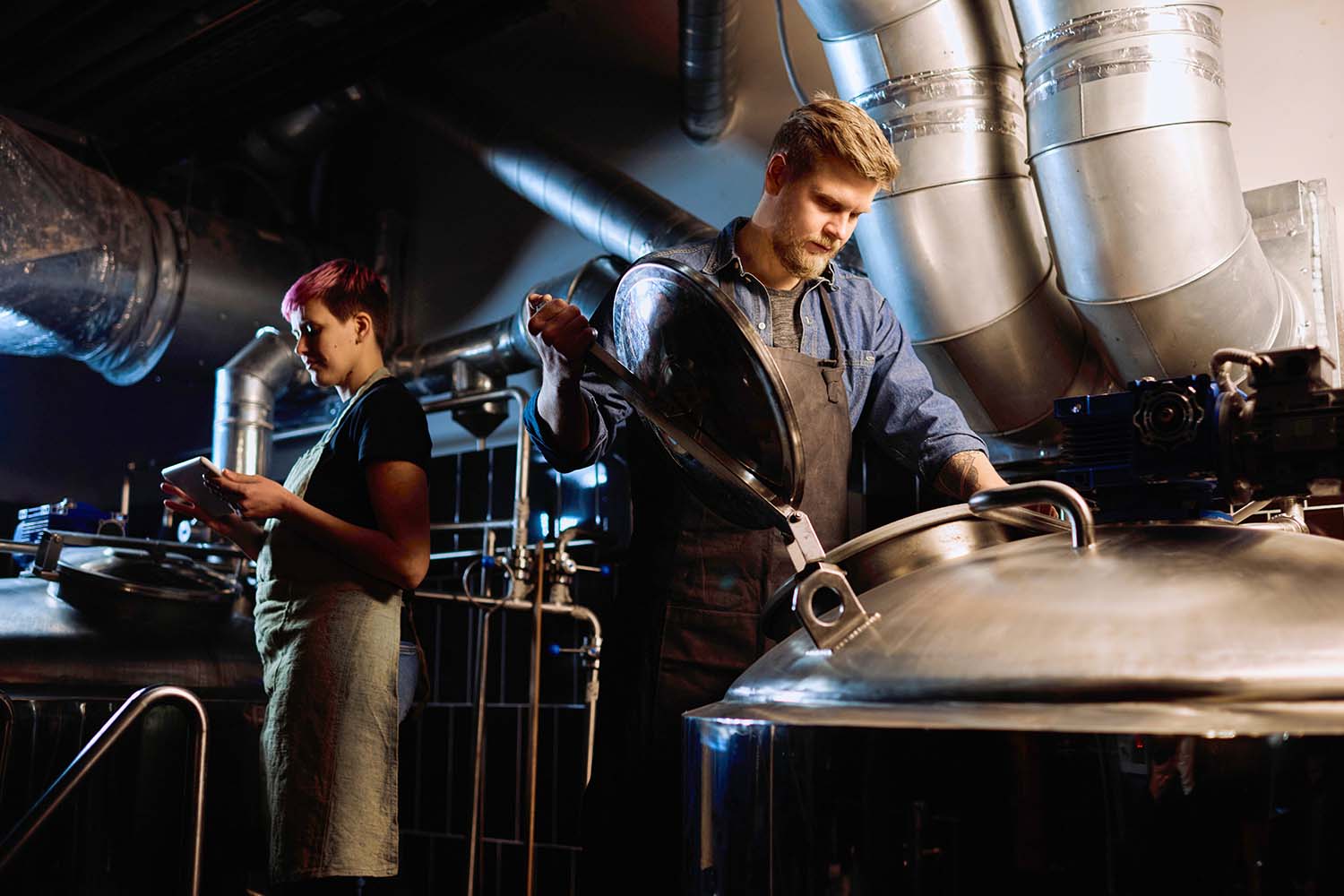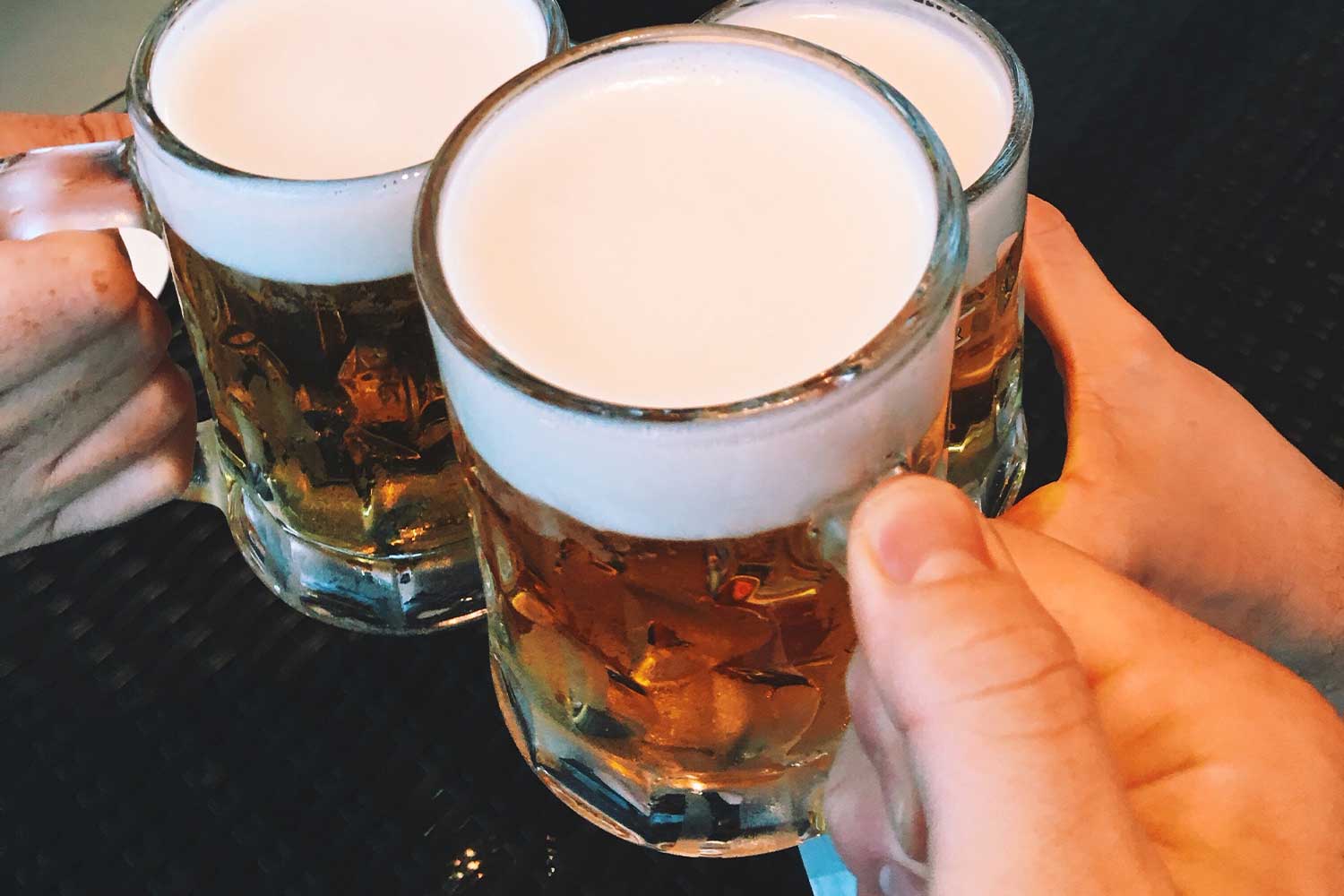What is Beer?
Beer as we all know is an alcoholic drink obtained from the fermentation of wort which is the name for the unfermented beer containing malt and hops, which vary depending on beer type and flavour.
The basic ingredients entering a beer factory are water, barley to be malted and cereals (or their derivatives) together with a series of secondary ingredients such as hop extracts and technological aids to be used during various phases of the process.
The final product is a liquid which varies from golden yellow to dark brown in colour and has a flavour which can be bitter with a varying aroma of malt and hops.
The origins of beer go back thousands of years today it is one of the most widespread alcoholic drinks in the world covering markets of global dimensions.
When it comes to factories, especially for those with a considerable production capacity, over several years we have seen a constant process of plant modernisation aimed at progressive automation of the entire production line which in the most modern breweries may even be completely monitored from a single control-room.
There continues to be a trend towards automation of the brewing industry and with industry 4.0 measurement in the process itself has become more and more critical. Maselli have a series of products specifically designed to meet needs of the modern beer production facility.
A typical beer factory
The brewing of beer is basically a succession of procedures which overall are common to all breweries, including even the smallest. However, the analysis of each single step may present quite significant variations in execution
Malting
The most important raw material for beer production is barley and the best variety. Malt is barley which has been allowed to germinate at a specific level of humidity. Germination causes a series of enzymes contained in the seed to break down the starches into easily fermentable sugars.
The purified barley, free from foreign substances is first immersed in water. The hydrated seeds are then taken to a germination chamber for a process which lasts between 5 – 7 days and is interrupted when the rootlet reaches a size equal to approximately ¾ of the original hydrated seed.
The main aim of this germination operation is to obtain the formation, within the seed, of the a-amylase enzyme and the release of the already present b-amylase. Their simultaneous presence is essential in that each one of them is able to break down the chain of amylase and amylopectin in the seed in a different way and only the combined action of the two enzymes produces the best possible conversion of the two starches into b-maltose with a minimum of b-destrin residues.
At the end of the germination process the so-called green malt is obtained which holds a water content of approximately 40 – 45%. Green malt must be processed immediately as it cannot be preserved in any way. In order to inhibit the germination process before the seed begins to metabolize its food reserves in an attempt to grow further, the green malt is kiln dried. Drying is carried out in two phases, the first is carried out at a low temperature, this is followed by roasting at higher temperatures.
The temperature of the second roasting phase differs depending on the type of beer it is to be used for: light malt is roasted at approximately 85°C and is used mainly for producing beer with a light delicate flavour, dark malt on the other hand is roasted at 100°C and is used for making beer with a stronger taste and caramelised malt, roasted at 110°C is for dark beer.
Analysis points:
Extraction (mashing – mash tun – lauter tun) – Technology UR24 Refractometer
This phase is rather complex and is critical for the quality of the final product. The purpose of this phase, carried out in characteristic boilers usually made from copper, is to extract all the substances which are needed for the following brewing steps from the malt grains, obtaining what is commonly known as wort.
Usually malted barley and other cereals (or their derivatives) are crushed into a coarse flour known as grist to obtain a homogeneous mass which can easily be strained out in the following steps which are basically made up of infusion in stages.
The grist is then added to hot water to obtain the first mixture known as mash which is then poured into a special tank called a mash tun. The mash is stirred to obtain an homogeneous mixture. Careful temperature control is required as it is during this phase that real extraction by infusion takes place.
The mash is transferred to a third tank, the so-called Lauter Tun, where the wort is obtained which at this stage is still “raw”, in other words it must still undergo final treatment. During the lautering stage most of the enzymatic reactions are completed, which continue throughout all the extraction phases, and which are responsible for the formation of the main characteristic substances of the final product (but also of undesirable sulphurous by-products).
On leaving the Lauter Tun, the product is transferred to a whirlpool filtering system which separates the ground malt and cereals from the liquid fraction which is then sent on to the following stage in the brewing process.
Wort Boiling – UR24 Process refractometer
This ‘cooking’ stage is of the utmost importance because it simultaneously serves various purposes which are summarised below:
- Water evaporation (concentration);
- Sterilisation of the wort and deactivation of the enzymes.
- Obtain the desired extracts from the hops (which contribute flavour and bitterness)
- Formation and precipitation of protein-tannin compounds (hot trub) and removal of undesirable malt and hop compounds.
- Formation of reducing compounds;
- Brown the wort.
- Acidification of the wort (decrease in the pH).
- Stripping of Dimethyl Sulphide (DMS; cause of unpleasant odours) in the vacuum phase.
Cooking occurs in the so-called brew kettle which is nothing more than an enormous cauldron / evaporator which may have a capacity of up to 100 m3 It is fitted with coils or external heat exchanging tube bundles and recirculation pumps. The head of the system is connected to a barometric condensation system and vacuum machines which remove and condense the outlet steam.
The process is executed in batches and lasts about 2 – 3 hours; the initial pressure is atmospheric, and the temperature is around 80 – 90 °C, towards the end of the process however the pressure is lowered by a few hundred mbar and the temperature is raised to almost 105°C.
It is during this last “temperature step” that so-called stripping of the so-called undesirable substances such as DMS occurs and the concentration of the wort, which due to the addition of various additive solutions (hop extract and flavouring, calcium chloride, etc.) has been slightly diluted. During this process trub forms, a coagulation of precipitates and protein and fibrous residues which survived the journey from the mash mixer and the whirlpool filtering system.
At the end of this process the product is sent onto another filtering stage to eliminate all unwanted precipitates and flocculates. It is then cooled in a chiller which is nothing more than an efficient heat exchanger which recovers heat from the whole process.
Fermentation – BA06 UR29s Refractometer and sound velocity meter
The purpose of this process is obviously to transform most of the fermentable substances, which make up the so-called Original Gravity (measured in °P) into alcohol and carbon dioxide or rather into the final product, i.e. beer.
The wort at this stage usually has an average composition as follows: extract 110 – 115g/l, (12°P circa) reducing sugars 70 – 80g/l, amino acids 10 – 12g/l. The yeasts needed for fermentation are added to the wort mass after the stock has been carefully selected.
In the presence of oxygen, the sugars are transformed into carbon dioxide and water, simultaneously a vast quantity of energy is released which allows the yeast to reproduce freely. In the absence of oxygen sugars are transformed into ethyl alcohol and carbon dioxide but in these conditions the yeast is unable to reproduce, for this reason, after the initial yeast growing phase the influx of sterile air into the fermenting wort is interrupted to guide the process in the desired direction.
To give a general idea on the quantities transformed occurring, it is possible to say that for every 2 Kg of fermented sugar approximately 1 kg of carbon dioxide and 1 kg of ethyl alcohol are obtained; the temperature which develops is sufficient to raise the temperature of the beer mass by over 10 °C (in an 11 °Plato beer) if no cooling method is provided.
The yeasts adopted belong to the genus saccharomyces but depending on the type of micro-organism which prevails in the strain added to the wort, it is possible to obtain two fundamental fermentation processes, called “low” or “high” fermentation which are distinguishable by the type of stratification of the yeast colonies found at the end of the process – this may be a compact surface layer or a layer deposited on the bottom of the brewing vessel. At the end of each fermentation batch there remains an excess of yeasts; part of this is preserved at 2 – 4°C and after scrupulous selection, reused. Some yeast stocks are thus used for a great length of time, in fact some breweries can boast of yeast stocks which date back hundreds of years.
As in the wine sector, it is of the utmost importance to be able to continuously follow and monitor the degree of sugar conversion into alcohol.
At the end of fermentation, regardless of the technique employed, the beer must be left to undergo a period to mature at a controlled temperature during which time the taste is “refined” by a series of reactions which at a very slow pace continue to occur thanks to some of the yeast enzymes remaining, even though actual fermentation has ceased.
High Gravity Beer – BA06 UR29s Refractometer and Sound velocity meter
The so-called High Gravity process is a technological modification which is becoming ever more widespread. It consists in the fermentation of a wort whose initial concentration is quite high (25°P and over) compared to traditional wort. This produces a beer, or rather a “ferment” which is significantly richer (also in alcohol) as well as being slightly different in composition. The alcohol content in these products is around 7 – 8 %was opposed to a value of 4 – 5 %w in a common beer.
The high gravity process obviously has biochemical or technological requirements to make it suitable for producing special beers or beers with different characteristics. However, high gravity ferment is rarely bottled being used mainly to be corrected or slightly diluted (blending high gravity beer).
Bottling – BA06 Beer Analyser Alcohol, CO2 and O2
Even if bottling is the obvious conclusion of the brewing process, due Maselli’s particular interest in the instrumentation designed to control this phase, it is opportune to highlight one or two aspects found in the brewery.
Once the beer has matured sufficiently the beer must be filtered by special apparatus which can be large and rather complex. The quality of filtration is a fundamental process step for all beers and requires large, complex, and specialised apparatus requiring frequent washing and draining. The product contained in each vat is processed in a single operation and the filtered beer is stored in another tank which is in the filling room.
On route from the filtering room to the filler stock tank it is necessary to carry out quality control which fundamentally has two purposes:
– the first is to allow the “cutting” of the filtering heads which are “polluted” with washing water from the previous filter cleaning process
– the second is to check the legal alcohol parameters and the °P of the product which is to be bottled/kegged.
For the legal alcohol limit measurements, the instrumentation installed is not intended to make any adjustments but is essential when it is necessary to interface the system with a data acquisition system for creating accurate production reports needed for tax declarations on alcoholic products.
Trimming – BA06 UR29S Refractometer and Sound velocity meter
The trimming operation is necessary to lighten or correct the alcohol value (or °Plato) of a beer which has deliberately been made from the fermentation of a wort with a higher concentration than necessary. This operation is also called “standardization”.
The trimming process can be compared to the common soft drink mixer operation.
In these processes the CO2 parameter is controlled and regulated continuously.
Blending High Gravity – BA06 Beer Analyser Refractometer and Sound velocity meter + CO2
As already mentioned the fermented product of a high concentrate wort can be used in complementary products or to produce beers with normal Plato and alcohol parameters.
In the second case, after suitable filtering, blending with water is carried out following a method which is very similar to trimming but with the use of higher dilution ratios.
Obviously control of the CO2 content is of fundamental importance because of the dilution caused by the incoming liquid.
A significant aspect of this industry is legislation and the classification of beers depending on the degree of alcohol content, generally measured as a percentage of alcohol in the beverage’s total volume alcohol by volume or the quantity of fermentable sugar present in the wort before fermentation (Original Gravity) measured in degrees Plato. Analysis of this alcohol leven and parameters including Plato, Original Gravity, Specific Gravity, Kcal, CO2, O2 content throughout the process are critical and this is where Maselli in line systems and the range of lab and portable devices can be invaluable to the modern brewing process.










